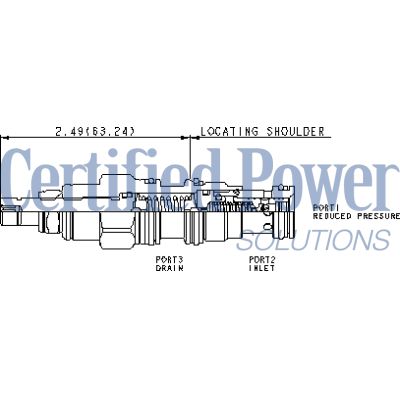SUN HYDRAULICS
RED-REL CART
PBDBLNN
$72.01 USD
- SUN HYDRAULICS
- Material:PBDBLNN
- Model:PBDB-LNN
- Summary:RED-REL CART
Quantity in stock: 7
***Disclaimer: The following summary contains information gathered from various sources such as product descriptions, technical specifications and catalogs. While efforts have been made to provide accurate details, inaccuracies may occur. It is advised to verify all information by contacting Sun Hydraulics directly.***
The Sun Hydraulics PBDBLNN (PBDBLNN) is a pilot-operated, pressure-reducing valve designed to manage high primary pressures at inlet port 2 and maintain a constant reduced pressure at port 1. This feature allows for efficient operation of circuits with multiple pressure requirements using a single pump. The valve is part of a series where all three-port pressure reducing and reducing-relieving cartridges are physically interchangeable, sharing the same flow path and cavity for a given frame size. It incorporates Sun's floating style construction to minimize internal part binding due to excessive installation torque or variations in cavity/cartridge machining. The PBDBLNN model is equipped with a main stage orifice protected by a 150-micron stainless steel screen, ensuring durability and reliability under various operating conditions. The valve showcases stable performance with exceptionally flat pressure-flow characteristics and low hysteresis, making it suitable for applications requiring precise pressure regulation. The maximum operating pressure for this model reaches up to 5000 psi (350 bar), with control pilot flow ranging from 7 to 10 in\u00b3/min (0.11 to 0.16 L/min). This cartridge valve is designed for ease of installation with specific torque settings: Valve Installation Torque is between 30-35 lbf ft (41-47 Nm), and Locknut Torque is between 80-90 lbf in (9-10 Nm). It features an adjustment screw internal hex size of 5/32 in. (4 mm) and a locknut hex size of 9/16 in. (15 mm). For systems using phosphate ester fluids, cartridges configured with EPDM seals are available, though exposure to petroleum-based fluids should be avoided as it may damage the seals. Overall, the Sun Hydraulics PBDBLNN offers reliable performance in managing complex hydraulic systems where precise pressure control is essential.
The Sun Hydraulics PBDBLNN (PBDBLNN) is a pilot-operated, pressure-reducing valve designed to manage high primary pressures at inlet port 2 and maintain a constant reduced pressure at port 1. This feature allows for efficient operation of circuits with multiple pressure requirements using a single pump. The valve is part of a series where all three-port pressure reducing and reducing-relieving cartridges are physically interchangeable, sharing the same flow path and cavity for a given frame size. It incorporates Sun's floating style construction to minimize internal part binding due to excessive installation torque or variations in cavity/cartridge machining. The PBDBLNN model is equipped with a main stage orifice protected by a 150-micron stainless steel screen, ensuring durability and reliability under various operating conditions. The valve showcases stable performance with exceptionally flat pressure-flow characteristics and low hysteresis, making it suitable for applications requiring precise pressure regulation. The maximum operating pressure for this model reaches up to 5000 psi (350 bar), with control pilot flow ranging from 7 to 10 in\u00b3/min (0.11 to 0.16 L/min). This cartridge valve is designed for ease of installation with specific torque settings: Valve Installation Torque is between 30-35 lbf ft (41-47 Nm), and Locknut Torque is between 80-90 lbf in (9-10 Nm). It features an adjustment screw internal hex size of 5/32 in. (4 mm) and a locknut hex size of 9/16 in. (15 mm). For systems using phosphate ester fluids, cartridges configured with EPDM seals are available, though exposure to petroleum-based fluids should be avoided as it may damage the seals. Overall, the Sun Hydraulics PBDBLNN offers reliable performance in managing complex hydraulic systems where precise pressure control is essential.
Pilot-operated, pressure reducing valves reduce a high primary pressure at the inlet (port 2) to a constant reduced pressure at port 1, allowing circuits with multiple pressure requirements to be operated using a single pump.
- All three-port pressure reducing and reducing/relieving cartridges are physically interchangeable (i.e. same flow path, same cavity for a given frame size). When considering mounting configurations, it is sometimes recommended that a full capacity return line (port 3) be used with reducing/relieving cartridges.
- Full reverse flow from reduced pressure (port 1) to inlet (port 2) may cause the main spool to close. If reverse free flow is required in the circuit, consider adding a separate check valve to the circuit.
- If pilot flow consumption is critical, consider using direct acting reducing/relieving valves.
- Main stage orifice is protected by a 150 micron stainless steel screen.
- Recommended maximum inlet pressure is determined by the adjustment range. Ranges D, E, N, and Q are tested with a 2000 psi (140 bar) maximum differential between inlet and reduced pressure. Ranges A, B, and H are tested with a 3000 psi (210 bar) maximum differential between inlet and reduced pressure. Ranges C and W are tested with 5000 psi (350 bar) of inlet pressure.
- Pilot operated valves exhibit exceptionally flat pressure/flow characteristics, are very stable and have low hysteresis.
- Pressure at port 3 is directly additive to the valve setting at a 1:1 ratio and should not exceed 5000 psi (350 bar).
- Pilot operated reducing, reducing/relieving valves by nature are not fast acting valves. For superior dynamic response, consider direct acting valves.
- W and Y controls (where applicable) can be specified with or without a special setting. When no special setting is specified, the valve is adjustable throughout its full range using the W or Y control. When a special setting is specified, this setting represents the maximum setting of the valve.
- Cartridges configured with EPDM seals are for use in systems with phosphate ester fluids. Exposure to petroleum based fluids, greases and lubricants will damage the seals.
- Corrosion resistant cartridge valves are intended for use in corrosive environments and are identified by the model code suffix /AP for external stainless steel components, or /LH for external zinc-nickel plated components. See the CONFIGURATION section for all options. For further details, please see the Materials of Construction page located under TECH RESOURCES.
- Incorporates the Sun floating style construction to minimize the possibility of internal parts binding due to excessive installation torque and/or cavity/cartridge machining variations.
| Cavity | T-11A |
| Series | 1 |
| Capacity | 10 gpm40 L/min. |
| Factory Pressure Settings Established at | blocked control port (dead headed)blocked control port (dead headed) |
| Maximum Operating Pressure | 5000 psi350 bar |
| Control Pilot Flow | 7 - 10 in³/min.0,11 - 0,16 L/min. |
| Adjustment - Number of Clockwise Turns to Increase Setting | 55 |
| Valve Hex Size | 7/8 in.22,2 mm |
| Valve Installation Torque | 30 - 35 lbf ft41 - 47 Nm |
| Adjustment Screw Internal Hex Size | 5/32 in.4 mm |
| Locknut Hex Size | 9/16 in.15 mm |
| Locknut Torque | 80 - 90 lbf in.9 - 10 Nm |
| Model Weight | .30 lb0,15 kg |
| Seal kit - Cartridge | Viton: 990-011-006 |
Show FAQ
Additional Resources
- QuickDesign with SmartConnect Offers Drag-and-Drop Schematic Tool
- Sun Expands Corrosion-Resistant Solutions
- Series 4 PLUS Cartridges Offer Higher Flows with Lower Pressure Losses
- Sun Offers Zinc-Nickel Plating for Corrosion Resistance
- Sun Cartridges with EPDM Seals
- Manufacturing Sun Cartridge Cavities
- Reducing and Reducing/Relieving Valves
- Fluid and Temperature Recommendations
- Performance Data
- Sun's Floating Style Screw-In Cartridge
- Units of Measure, Settings, and Conversions
- Sun Model Code Explanation; 999-901-334
- Cavity Information (S-171) and Tooling
- Cartridges: Materials of Construction
Notes:
- Maximum pressure differentials for spring ranges: A and B are 3000 psi (210 bar) N and Q are 2000 psi (140 bar) W is 5000 psi (350 bar)inlet pressure
- For Series 1 cartridges configured with an O control (panel mount handknob), a .75 in. (19 mm) diameter hole is required in the panel.

